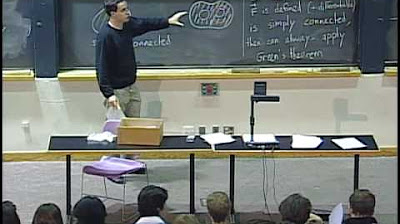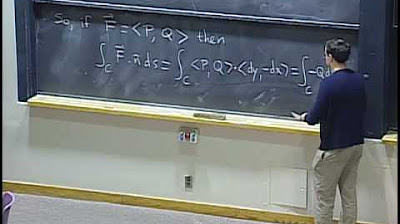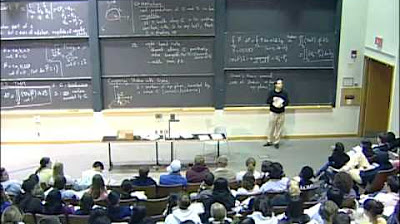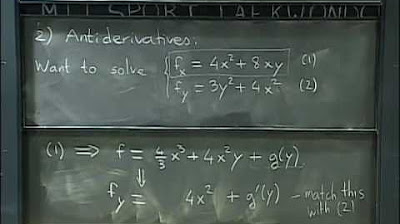Lec 30: Line integrals in space, curl, exactness... | MIT 18.02 Multivariable Calculus, Fall 2007
TLDRThis lecture delves into the derivation of the diffusion equation from physical principles and the divergence theorem, emphasizing the relationship between flow and concentration gradients. It transitions to exploring line integrals in 3D, illustrating computation methods and the significance of parameterization. The lecture also covers the concept of conservative vector fields and introduces the criteria for a field to be a gradient field, using examples to demonstrate the process of finding potentials and applying the fundamental theorem of calculus. Finally, it touches on the concept of curl in 3D, explaining its role in measuring the non-conservative aspects of a vector field and its geometric interpretation related to rotation in a fluid flow.
Takeaways
- 📚 The lecture script is from an MIT OpenCourseWare course, emphasizing the importance of donations for high-quality educational resources.
- 🏫 The last lecture was abruptly ended due to time constraints, and the main point was the derivation of the diffusion equation from two key pieces of information related to substance concentration and flow.
- 🔄 The diffusion equation was derived from the physical principle of flow from high to low concentration and the divergence theorem, resulting in a relationship involving the Laplacian of the concentration function.
- 📈 The method for computing line integrals in 3D involves parameterizing the curve and integrating the dot product of the vector field and the differential displacement vector.
- 🔩 The work done by a field along a curve in 3D can be calculated by integrating the components of the force vector field cross the differential displacement components along the curve.
- 🔍 The script provided an example of computing a line integral for a given vector field and curve, emphasizing that the method is similar to that in 2D but includes a z-coordinate.
- 🔑 The concept of a conservative vector field was introduced, with the script explaining that the line integral of a gradient field depends only on the endpoints and not the path taken.
- 🔍 The script demonstrated how to determine if a vector field is a gradient field by checking if the mixed partial derivatives are equal, a condition that must be met for exactness.
- 📝 The process of finding a potential function for a given vector field was outlined, involving integrating the components of the field with respect to the corresponding variables and comparing the results.
- 🌀 The script introduced the concept of curl in 3D, which measures the rotation component of a vector field and is crucial for understanding fluid dynamics and motion.
- 📚 The curl is defined as a vector field resulting from the cross product of the del operator and the vector field, indicating the angular velocity and axis of rotation in a flow.
Q & A
What is the main point of the lecture before the break that the instructor wanted to summarize?
-The main point was to explain the derivation of the diffusion equation from two pieces of information: the physical principle that flow goes from high to low concentration, and the divergence theorem, which ultimately leads to the equation relating the change in concentration over time to the Laplacian of the concentration function.
What is the formula for the work done by a vector field F along a curve C in space?
-The work done by the field is given by the line integral along C of the dot product of F and dr, where dr is the differential displacement vector in space with components dx, dy, and dz.
How does the presence of a z-coordinate affect the computation of a line integral?
-The presence of a z-coordinate does not significantly change the method of computing a line integral; it simply adds another term to the integral, Rdz, where R is the z-component of the vector field F.
What is the significance of parameterizing a curve in space when computing a line integral?
-Parameterizing a curve allows us to express the components of the curve and the differential displacement vector in terms of a single parameter. This simplifies the line integral into a single integral with respect to that parameter, making it easier to compute.
Can you provide an example of a vector field and a curve for which the line integral computes to a simple value?
-An example given in the script is a vector field with components yz, xz, and xy, and a curve parameterized by x=t^3, y=t^2, z=t for t going from 0 to 1. The line integral of this field along this curve evaluates to 1.
Why does the line integral of a gradient field yield the same result for different paths between the same two points?
-The line integral of a gradient field is path-independent because the field is conservative. This means that the work done by the field is the same regardless of the path taken between two points, as long as they start and end at the same potential values.
What is the fundamental theorem of calculus for line integrals, and how does it simplify the computation of line integrals for gradient fields?
-The fundamental theorem of calculus for line integrals states that the line integral of a gradient field is equal to the value of the potential function at the final point minus the value at the starting point. This simplifies the computation by eliminating the need to parameterize and integrate along the path, provided a potential function is known.
What are the conditions that must be met for a vector field to be considered a gradient field in three dimensions?
-For a vector field with components P, Q, and R to be a gradient field, the mixed partial derivatives must be equal, which gives us three conditions: P_y = Q_x, P_z = R_x, and Q_z = R_y.
How can one remember the formula for the curl of a vector field in three dimensions?
-The formula for the curl can be remembered using the del (∇) cross F notation, which represents the cross product between the del operator and the vector field F. This notation helps visualize the structure of the formula without memorizing each term.
What does the curl of a vector field measure, and how is it related to the field being conservative?
-The curl of a vector field measures the rotation or circulation component of the field. A vector field is conservative if and only if its curl is zero in a simply connected region, indicating no rotation.
What is Stokes' theorem, and how does it relate to the concepts discussed in the script?
-Stokes' theorem is a generalization of Green's theorem in three dimensions. It relates the surface integral of the curl of a vector field to the line integral of the field around the boundary of that surface. It is the next topic to be discussed after the concepts of line integrals and curl presented in the script.
Outlines
📚 Introduction to Diffusion Equation and Line Integrals in 3D
The script begins with an acknowledgment of the support for MIT OpenCourseWare and a brief apology for an abrupt ending in the previous lecture. The main topic of the lecture is introduced as line integrals in 3D, which parallels the 2D case but with the additional complexity of the z-coordinate. The diffusion equation is derived from two pieces of information: the physical principle of flow from high to low concentration and the divergence theorem. The diffusion equation is expressed as ∂u/∂t = -div(F), where F is the flow vector field and u is the concentration function. The lecture then transitions into the computation of line integrals in 3D, using the dot product of the vector field with the differential displacement vector.
🔍 Detailed Explanation of Line Integrals and Work Done by a Field
This paragraph delves into the specifics of calculating line integrals in 3D, emphasizing the method of parameterizing a curve and integrating with respect to that parameter. An example is provided with a vector field and a curve defined by parametric equations. The process of differentiating the parametric equations to find dx, dy, and dz, and then substituting these into the line integral formula is demonstrated. The example concludes with the computation of work done by the field along the curve, resulting in an integral that simplifies to a straightforward calculation.
🔗 The Concept of Conservative Vector Fields and Line Integrals Along Different Paths
The script explores the concept of conservative vector fields, where the line integral does not depend on the path taken but only on the endpoints. An example is given with a vector field and a path composed of three segments, leading from the origin to the point (1,1,1). The line integral is computed for each segment, and it is shown that even though the paths are different, the final result is the same due to the conservative nature of the field. This property is attributed to the vector field being the gradient of a potential function.
📘 Fundamental Theorem of Calculus and Conservative Fields
The paragraph introduces the application of the fundamental theorem of calculus to line integrals in conservative fields. It explains that once a potential function is identified, the line integral can be computed as the difference in potential values between the endpoints, rather than explicitly calculating the integral along the path. The example from the previous paragraph is revisited, and the potential function is derived, confirming the result obtained through the line integral calculation.
🔄 Criteria for a Vector Field to be a Conservative Field in 3D
The criteria for a vector field to be conservative in three dimensions are discussed. It is explained that the mixed partial derivatives of the components of the vector field must be equal for the field to be conservative. This leads to three conditions that must be satisfied: ∂P/∂y = ∂Q/∂x, ∂P/∂z = ∂R/∂x, and ∂Q/∂z = ∂R/∂y. The paragraph also touches on the importance of the vector field being defined in a simply connected region for these conditions to ensure the field is conservative.
📚 Method for Finding a Potential Function Given a Conservative Vector Field
The paragraph outlines the method for finding a potential function when a vector field is conservative. It describes two approaches: one involves integrating along a chosen path from a fixed point to find the potential function at any point, and the other involves solving for the potential function using anti-derivatives based on the given components of the vector field. The process of integrating each component with respect to its corresponding variable and comparing the results to find the potential function is detailed.
🌀 Introduction to Curl in 3D and Its Geometric Interpretation
The concept of curl in three-dimensional vector fields is introduced, explaining that it measures the rotation component of a field. The mathematical definition of curl is provided, and the structure of the formula is explained using the del operator and cross product notation. The geometric interpretation of curl is discussed, relating it to the angular velocity and axis of rotation in a fluid flow. The paragraph concludes with a teaser for Stokes' theorem, which will be covered in a subsequent lecture.
Mindmap
Keywords
💡Creative Commons license
💡Diffusion equation
💡Vector field
💡Laplacian
💡Line integrals
💡Gradient field
💡Parameterization
💡Conservative field
💡Curl
💡Stokes' theorem
Highlights
MIT OpenCourseWare offers high-quality educational resources for free, supported by donations.
Diffusion equation derived from two key pieces of information: physics-based flow from high to low concentration and the divergence theorem.
The diffusion equation links the rate of change of concentration over time with the Laplacian of the concentration function.
Line integrals in 3D are computed similarly to 2D, but with consideration of the z-coordinate.
Work done by a field is calculated as the line integral of the force field dot product with the differential displacement vector.
Parameterizing a curve in 3D space allows for the computation of line integrals by integrating with respect to the parameter.
Example calculation demonstrates the method of computing line integrals for work done by a field along a given curve.
The concept of conservative vector fields and their relation to the fundamental theorem of calculus for line integrals.
Conservative fields have the same line integral value for different paths between the same two points, due to the absence of a circulation component.
Gradient fields can be identified by checking if the mixed partial derivatives are equal, extending the 2D condition to 3D.
Three conditions must be met for a vector field to be a gradient field: P_y = Q_x, P_z = R_x, and Q_z = R_y.
The method to find a potential function for a given vector field involves integrating each component with respect to its corresponding variable.
An example demonstrates the process of finding a potential function for a vector field by systematically integrating and comparing partial derivatives.
Curl in 3D is introduced as a measure of how much a vector field fails to be conservative, indicating the rotation component in a field.
Curl is computed using the cross product of the del operator with the vector field, resulting in a vector field rather than a scalar.
Geometric interpretation of curl reveals it as a measure of the rotation in a velocity field, providing insight into the motion of fluid particles.
Stokes' theorem is previewed as the next topic, which will connect to the concept of curl and provide a generalization of Green's theorem for work in 3D.
Transcripts
Browse More Related Video

Lec 20: Path independence and conservative fields | MIT 18.02 Multivariable Calculus, Fall 2007

Lec 24: Simply connected regions; review | MIT 18.02 Multivariable Calculus, Fall 2007

Lec 23: Flux; normal form of Green's theorem | MIT 18.02 Multivariable Calculus, Fall 2007

Lec 31: Stokes' theorem | MIT 18.02 Multivariable Calculus, Fall 2007

Lec 21: Gradient fields and potential functions | MIT 18.02 Multivariable Calculus, Fall 2007

Calculus 3: Lecture 15.1 Vector Fields
5.0 / 5 (0 votes)
Thanks for rating: